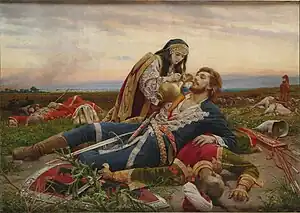Serbian folklore is the folk traditions among ethnic Serbs. The earliest examples of Serbian folklore are seen in the pre-Christian Slavic customs transformed into Christianity.
Roots and characteristics
Folklore
The Apostles of the Slavs, Cyril and Methodius, have been venerated by Serbian Orthodox Christians since their Christianization in 867,[1] they have been considered Serbs by historians.[2]
In Krajište and Vlasina there are epic stories of the extermination of Roman males in a battle, and of the settling of Russians (Antes)[3][4]
Unlike East Slavsic mythology, south slavic mythology distinguishes between two different kinds of dragons: the benevolent zmej and the malevolent ala.[5]
Serbian Epic poetry

Dying Pavle Orlović is given water by a maiden who seeks her fiancée at the battlefields of Kosovo Polje (Gazimestan), he tells her that her love, Milan, and his two blood-brothers Miloš and Ivan were killed during the Battle of Kosovo by the Ottoman Turks.
-taklolen from the Serb Epic poem
Serbian epic poetry is a form of epic poetry written by Serbs originating in today's Serbia, Bosnia and Herzegovina and Montenegro. The main cycles were composed by unknown Serb authors between the 14th and 19th centuries. They are largely concerned with historical events and personages.
The corpus of Serbian epic poetry is divided into cycles:
- Non-historic cycle
- Pre-Kosovo cycle - poems about events that predate the Battle of Kosovo - songs about royal family-Nemanjići and folk songs
- Cycle of Kraljević Marko
- Kosovo cycle - poems about events that happened just before and after the Battle of Kosovo (no poem covers the battle itself)
- Post-Kosovo cycle - poems about post-Battle events
- Poems about the liberation of Serbia
- Poems about the liberation of Montenegro
See also
References
- ↑ Komatina, Predrag (2015). "The Church in Serbia at the Time of Cyrilo-Methodian Mission in Moravia". Cyril and Methodius: Byzantium and the World of the Slavs. Thessaloniki: Dimos. pp. 711–718.
- ↑ Calendar of Resurrection; Bašić 1913:55
- ↑ Николић 1912: 165-167
- ↑ "Пројекат Растко: Đorđe Janković : The Slavs in the 6th century North Illyricum".
- ↑ Pócs, Éva (1989). Fairies and Witches at the Boundary of South-Eastern and Central Europe. FF Communications 243. p. 18. ISBN 9789514105975.